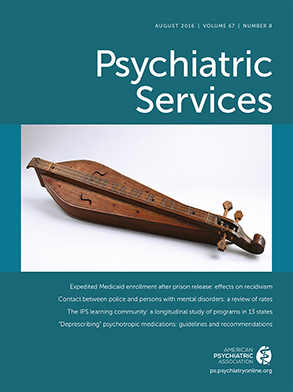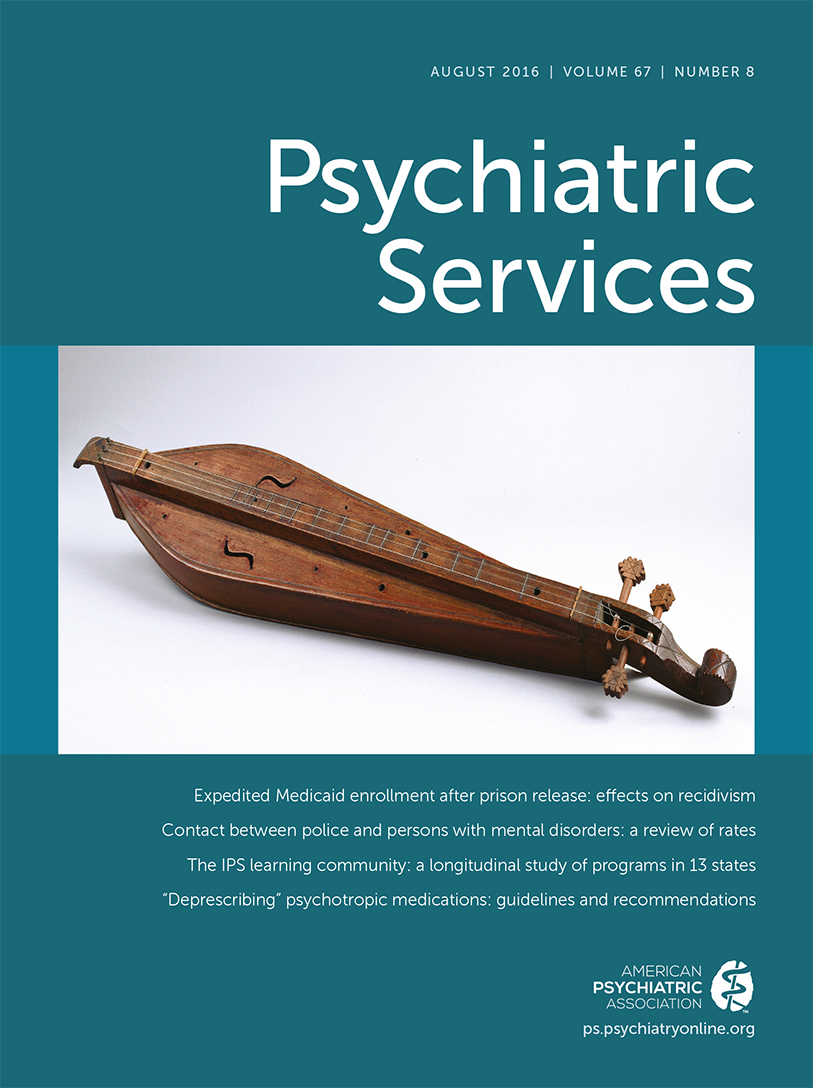The Institute of Medicine has called for transformation of health systems into learning health care systems, whereby patient care and medical research are integrated to allow care practices to be continuously studied and improved (
1). Necessary components include a culture of shared responsibility, universal electronic medical records (EMRs), tools to mine clinical care data, and a research paradigm that includes transforming care on the basis of knowledge gained from those data (
1,
2).
Unfortunately, there is an increasing disconnect between discovery and application in medicine; what is learned through research is often neither relevant nor implemented, and operational leaders must make decisions based on hunches rather than on data (
3). A particularly important component of a learning health care system is an emphasis on sharing data and insights among care delivery leaders, clinicians, and researchers through a continuous feedback loop that efficiently improves care. This practice-based learning is an important complement to traditional controlled trials, which, although useful, can be slow and expensive, with results that are difficult to generalize (
4).
An evolving model of a learning mental health care system is being facilitated by the Mental Health Research Network (MHRN) (hcsrn.org/mhrn/en/), funded by the National Institute of Mental Health (NIMH). MHRN was founded in 2010 and includes researchers embedded in 13 health systems serving nearly 13 million patients across 15 states. MHRN was envisioned as a national laboratory to study and improve mental health care, taking advantage of defined populations and EMR data systems. MHRN strives to foster engaged scholarship between those who conduct and those who use research via an MHRN work group that tracks and shares engagement lessons among the 13 members.
This column describes efforts by MHRN partners to prevent suicide among patients served by MHRN care systems.
Reducing Suicide Risk
MHRN’s collaboration to understand and reduce suicide risk is an example of engaged scholarship within the network. Previous research on care management and collaborative care for depression demonstrated the importance of measuring depression symptoms in improving outcomes (
5), and as a result, many MHRN care systems began using the nine-item Patient Health Questionnaire (PHQ-9) (
6) to screen for and monitor depression. Increased PHQ-9 use created both a concern and an opportunity: clinicians were concerned about what constitutes appropriate risk assessment and follow-up for patients reporting thoughts of suicide or self-harm, and MHRN researchers were able to use data recorded by clinicians to systematically address that concern.
Early findings indicated that 6% of patients who completed a PHQ-9 reported on item 9 that they had thoughts that they would be better off dead or of hurting themselves more than half the days (a score of 2) or nearly every day (a score of 3) in the previous two weeks. However, little evidence was available to determine whether these results predicted suicidal behavior. Thus researchers carefully reviewed data generated by the four MHRN health care systems administering the PHQ-9 most consistently. In a sample of over 1.2 million PHQ-9 scores completed by more than 500,000 outpatients, those who scored a 2 or 3 on item 9 were at significantly increased risk of a subsequent suicide attempt (
7). The positive predictive value for suicide attempts of a score of 2 or 3 was 4%, and the sensitivity was 50%. Surprisingly, this elevated risk persisted over two years. The health care systems had protocols to monitor and address patients’ immediate risk of suicide, but they did not have empirically based protocols to systematically address patients’ sustained suicide risk. Identification of this sustained risk led to four streams of action in MHRN health care systems, which are described below.
Practice change.
Because of the evidence of increased risk of suicide attempts, health systems and governing organizations felt compelled to act rather than to conduct an experiment. Some systems implemented more thorough assessments of suicide risk, most often with the Columbia–Suicide Severity Rating Scale (C-SSRS) (
8), for patients who reported suicidal ideation. At Group Health Cooperative in Washington State, a risk-specific follow-up protocol was implemented, dependent on the results of the C-SSRS, which includes safety planning and more frequent follow-up, with feedback to clinicians and clinics on their adherence to the protocol. At Kaiser Permanente Colorado, the behavioral health department used the findings to accelerate work that had begun as a quality improvement project to increase use of the C-SSRS. Similarly, the Henry Ford Health System used these data to inform implementation of its expanded outpatient depression and suicide screening protocol. In addition, partly on the basis of these MHRN findings, the Joint Commission recently issued a Sentinel Event Alert recommending that all patients be screened for suicidal ideation using a brief, standardized, evidence-based screening tool (
9), which will likely lead to more broad adoption of these tools throughout the country. In these examples, new research knowledge led quickly and efficiently to practice changes.
Effectiveness research.
Researchers and health care system leaders found little evidence for effective interventions to address the sustained suicide risk beyond the short-term crisis. Researchers at three MHRN health care systems—Group Health, HealthPartners, and Kaiser Permanente Colorado—obtained funding from the National Institutes of Health to conduct a large pragmatic trial of between-visit outreach programs to prevent suicide. The effectiveness of an online dialectical behavior therapy skills training program, supported by an online health coach, is being compared with a risk assessment and care management intervention and with usual care. All patients who score a 2 or 3 on item 9 of the PHQ-9 are automatically enrolled and randomly assigned to one of the three groups. Patients in the intervention groups are then invited to participate, with invitations sent by secure e-mail via the EMR, and suicide attempts are assessed for all patients in the three groups.
In designing this study, researchers were mindful that systems are unlikely to adopt a program if it is too costly or cumbersome. As part of the study, researchers are also examining the performance of the C-SSRS, because the usefulness of this tool in clinical care is largely unknown. Before implementation, researchers worked with local health care leaders to design the study in a way that would cause minimal disruption in clinical workflows. Fitting the intervention into existing workflows and making it as efficient as possible help ensure that these systems—and others—will be able to implement the strategies if they are found to be effective.
Exploratory research.
Health care system data revealed that among people who attempted suicide within 30 days of completing the PHQ-9, 25% had denied experiencing thoughts of self-harm on the PHQ-9. Health care leaders and researchers recognized a need to explore the low sensitivity (50%) of the PHQ-9 and better understand these “unexpected” suicide attempts. Subsequently, researchers at Group Health obtained funding from the American Foundation for Suicide Prevention to interview people who survived suicide attempts and had denied suicidal ideation on the PHQ-9. In addition, MHRN researchers obtained funding from NIMH to identify signals of suicide risk among individuals with no recorded mental health need in eight MHRN organizations, including a sample of more than 4,000 persons who died by suicide, the largest study of its kind among health care users in the U.S. general population.
Continuous learning in a national laboratory.
In addition to ongoing suicide prevention studies across the MHRN, many opportunities for partnership and improvement remain. MHRN’s Suicide Prevention Scientific Interest Group provides a forum for discussing these opportunities. Participants include embedded researchers at all MHRN sites, as well as many externally affiliated researchers and project officers from NIMH and the Substance Abuse and Mental Health Services Administration. These partnerships support the interest group as a national laboratory for future suicide prevention research and quality improvement.
Although partnering with clinicians and administrators in health systems is worthwhile, there are challenges to creating these relationships in the first place. Many researchers work in environments that are several steps removed from clinical care, leaving them unlikely to have significant relationships with care system leaders or to know how to create them. Building such partnerships takes time and trust, and researchers often need to take the initiative to reach out to their clinical partners. MHRN researchers have had success by serving on committees or work groups where care priorities are discussed and set. In this way, they develop needed relationships, as well as a deeper understanding of the pressures and knowledge gaps faced by care delivery teams. Not only does such partnering give researchers a chance to listen to their care delivery partners, it also allows them to educate health care leaders about the potential value of a learning health care system.
Once relationships between researchers and system leaders are established, multiple challenges remain. Clinical resources are limited. Care systems may be reluctant or unable to take on more responsibilities or significantly change workflows, and leaders may be reluctant to hire staff for temporary jobs that end when a grant ends. Instead, research is most likely to move forward when it is implemented in ways that are minimally disruptive to workflows and maximally feasible to sustain. Embedded researchers may find it easier to navigate when they also maintain a part-time clinical practice and have firsthand knowledge of the workflows and pressures. Alternatively, some care leaders have been willing to walk researchers through clinic workflows to promote this knowledge. Ultimately, this knowledge ensures that studies that are implemented and found to be effective are much more likely to continue and be spread after the research ends.
Another challenge is the potential for conflict between researchers who feel obliged to randomly assign patients to obtain scientific evidence and health care leaders who prefer to provide additional resources and the possibility of improved care for every patient. Other research designs, such as observational studies, pre-post designs, and stepped-wedge designs, may be both scientifically strong and more compatible with care system needs. Lack of alignment between the research and delivery system agendas presents another challenge. This is best overcome when all participants work to find common ground between issues that care partners and funding agencies regard as compelling—a goal that is becoming easier as funders face greater pressure to support work that directly improves care. A further challenge is the dissonance that can exist between clinical questions that need answers now and the comparatively slow pace of research funding and findings. Although the pace of funding remains slow and findings continue to be published in medical journals, embedded researchers are able to increase the rate of dissemination by sharing findings promptly and directly with health system partners. A final challenge is a lack of funding from grants or care systems to cover researchers’ time to implement study findings. Although a satisfactory solution to this barrier has not been found, this situation may change as funders face greater pressure to facilitate health care change.
Conclusions
Ultimately, the greatest benefit that researchers experience in working collaboratively with care system partners is the opportunity to improve care more efficiently and effectively than is otherwise possible—ideally by transforming care while simultaneously measuring the impact of the change. MHRN’s system partners highly value the role of research as it contributes to a learning health care organization, but relationships have taken careful nurturing over years. Care system leaders, who are under pressure to improve results in areas measured by the National Committee for Quality Assurance, the Joint Commission, the Physician Quality Reporting System initiative, and others, influence the selection process for projects in a manner that better aligns the work with key national priorities. Undertaking such studies ensures that findings will be more likely to have a meaningful impact on patients’ lives, the ultimate goal of our work.

